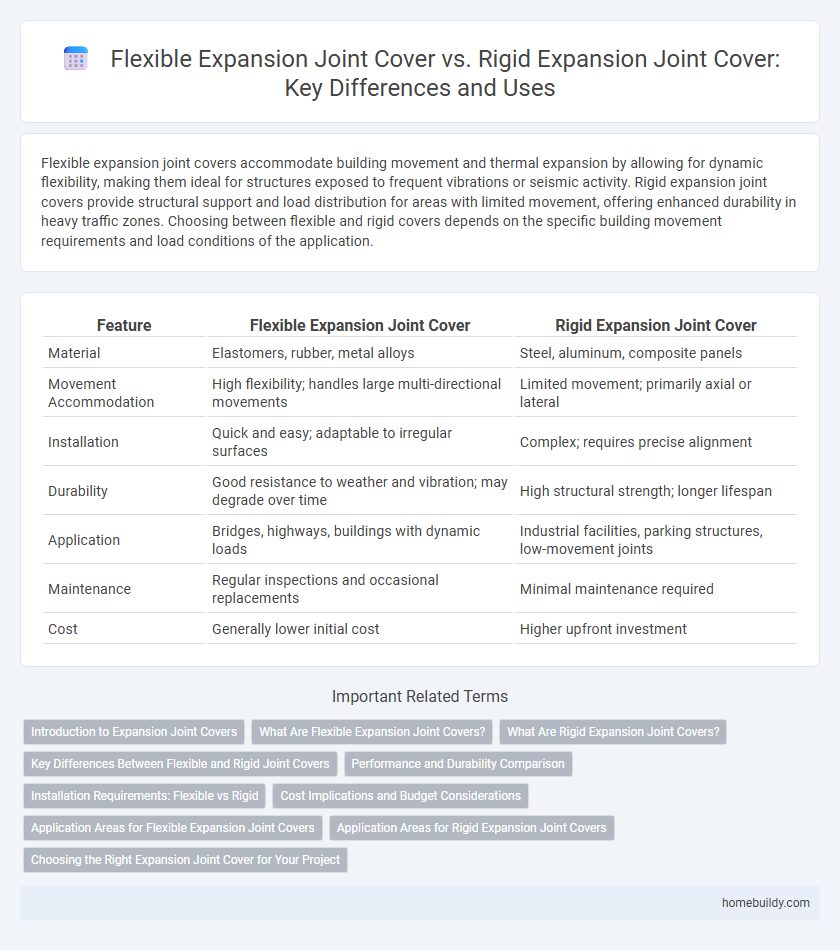Flexible expansion joint covers accommodate building movement and thermal expansion by allowing for dynamic flexibility, making them ideal for structures exposed to frequent vibrations or seismic activity. Rigid expansion joint covers provide structural support and load distribution for areas with limited movement, offering enhanced durability in heavy traffic zones. Choosing between flexible and rigid covers depends on the specific building movement requirements and load conditions of the application.
Table of Comparison
| Feature | Flexible Expansion Joint Cover | Rigid Expansion Joint Cover |
|---|---|---|
| Material | Elastomers, rubber, metal alloys | Steel, aluminum, composite panels |
| Movement Accommodation | High flexibility; handles large multi-directional movements | Limited movement; primarily axial or lateral |
| Installation | Quick and easy; adaptable to irregular surfaces | Complex; requires precise alignment |
| Durability | Good resistance to weather and vibration; may degrade over time | High structural strength; longer lifespan |
| Application | Bridges, highways, buildings with dynamic loads | Industrial facilities, parking structures, low-movement joints |
| Maintenance | Regular inspections and occasional replacements | Minimal maintenance required |
| Cost | Generally lower initial cost | Higher upfront investment |
Introduction to Expansion Joint Covers
Flexible expansion joint covers accommodate building movement through elastic materials like rubber or neoprene, providing excellent vibration absorption and water tightness. Rigid expansion joint covers utilize metal components such as aluminum or steel, offering high load capacity and durability for traffic-heavy areas. These covers ensure structural integrity by protecting joints from environmental stress and mechanical damage.
What Are Flexible Expansion Joint Covers?
Flexible expansion joint covers are designed to accommodate structural movements caused by thermal expansion, seismic activity, and vibrations, providing a continuous barrier that maintains building integrity. These covers use pliable materials such as elastomers or rubber, allowing them to absorb and adapt to multidirectional movements without damage. Their elasticity and durability make flexible expansion joint covers essential for applications requiring high performance in dynamic environments.
What Are Rigid Expansion Joint Covers?
Rigid expansion joint covers consist of solid metal or composite materials designed to bridge gaps between building sections while allowing limited movement. They provide high durability and load-bearing capacity, making them suitable for areas with heavy traffic or structural demands. Unlike flexible covers, rigid expansion joint covers accommodate primarily vertical movement without significant flexibility for lateral shifts.
Key Differences Between Flexible and Rigid Joint Covers
Flexible expansion joint covers accommodate movement through elastic materials like rubber or neoprene, providing superior adaptability to dynamic loads and thermal expansion. Rigid expansion joint covers consist of metal or composite plates that offer higher structural strength but limited flexibility, suitable for applications with predictable, minimal movement. Key differences include flexibility, material composition, and suitability for varying degrees of joint movement and load-bearing requirements.
Performance and Durability Comparison
Flexible expansion joint covers offer superior movement accommodation and better resilience to thermal expansion, making them ideal for dynamic environments with frequent structural shifts. Rigid expansion joint covers provide enhanced load-bearing capacity and durability under heavy traffic conditions but may be susceptible to cracking or damage under excessive movement. Performance efficiency of flexible covers excels in adapting to joint deformation, while rigid covers maintain structural integrity over prolonged heavy-duty use.
Installation Requirements: Flexible vs Rigid
Flexible expansion joint covers require less precise alignment during installation, accommodating structural movement and thermal expansion without compromising the seal, making them ideal for dynamic environments. Rigid expansion joint covers demand exact installation with strict alignment to ensure stability and load transfer, often involving heavy anchoring and precise measurement to prevent joint damage. Proper selection between flexible and rigid covers depends on site conditions, load requirements, and ease of installation to optimize performance and longevity.
Cost Implications and Budget Considerations
Flexible expansion joint covers often have higher initial costs due to the use of specialized materials and complex installation processes, but they can reduce long-term maintenance expenses by accommodating movement and preventing structural damage. Rigid expansion joint covers generally involve lower upfront investment but may incur increased repair costs over time as they lack the capacity to absorb building movements effectively. Budget considerations should include not only installation expenses but also lifecycle costs related to durability, maintenance frequency, and potential disruption caused by repairs.
Application Areas for Flexible Expansion Joint Covers
Flexible expansion joint covers are ideal for application areas requiring high movement accommodation such as seismic zones, pedestrian walkways, and bridge decks. They effectively absorb vibrations and thermal expansion, making them suitable for buildings subject to structural shifts or heavy traffic loads. Their versatility supports installation in various environments including airports, hospitals, and commercial centers where ongoing movement and durability are critical.
Application Areas for Rigid Expansion Joint Covers
Rigid expansion joint covers are ideal for heavy-duty industrial facilities, parking garages, and bridges where high load-bearing capacity and minimal movement are essential. These covers effectively accommodate thermal expansion and contraction in concrete structures while providing a durable surface resistant to heavy traffic and mechanical stress. Their robust design makes them suitable for areas with vehicular loads, seismic activity, and harsh environmental conditions.
Choosing the Right Expansion Joint Cover for Your Project
Flexible expansion joint covers accommodate multi-directional movement and provide superior vibration resistance, making them ideal for buildings subject to seismic activity or thermal expansion. Rigid expansion joint covers offer high load-bearing capacity and durability, suitable for heavy traffic areas such as bridges and industrial floors. Selecting the right expansion joint cover requires assessing movement types, load demands, and environmental factors to ensure structural integrity and long-term performance.
Flexible expansion joint cover vs Rigid expansion joint cover Infographic

 homebuildy.com
homebuildy.com